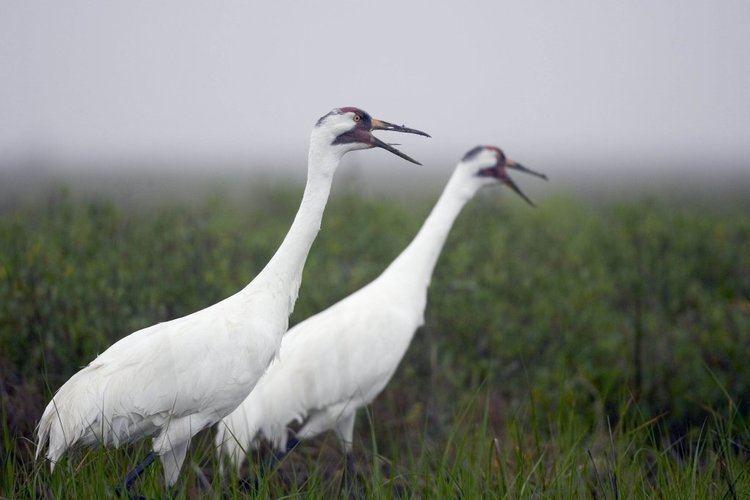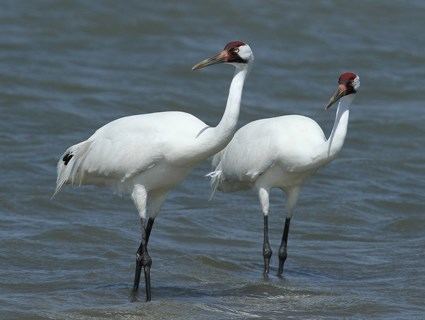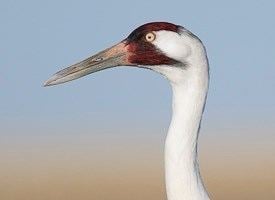Rank Species | Phylum Chordata Family Gruidae Higher classification Grus | |
 | ||
Similar Crane, Bird, Sandhill crane, Grus, Red‑crowned crane | ||
Flight to survive saving whooping cranes
The whooping crane (Grus americana), the tallest North American bird, is an endangered crane species named for its whooping sound. In 2003, there were about 153 pairs of whooping cranes. Along with the sandhill crane, it is one of only two crane species found in North America. The whooping crane's lifespan is estimated to be 22 to 24 years in the wild. After being pushed to the brink of extinction by unregulated hunting and loss of habitat to just 21 wild and two captive whooping cranes by 1941, conservation efforts have led to a limited recovery. As of February 2015, the total population was 603 including 161 captive birds.
Contents
- Flight to survive saving whooping cranes
- Whooping crane calls
- Description
- Habitat
- Predators
- Diet
- Individual recognition territorial and partnership fidelity
- Conservation efforts
- References

Whooping crane calls
Description

An adult whooping crane is white with a red crown and a long, dark, pointed bill. Immature whooping cranes are cinnamon brown. While in flight, their long necks are kept straight and their long dark legs trail behind. Adult whooping cranes' black wing tips are visible during flight.

The species can stand up to 1.5 meters (4.9 feet) and have a wingspan of 2.3 meters (7.5 feet). Males weigh on average 7.3 kg (16 lb), while females weigh 6.2 kg (14 lb) on average (Erickson, 1976). The body length averages about 132 cm (52 in). The standard linear measurements of the whooping cranes are a wing chord length of 53–63 cm (21–25 in), an exposed culmen length of 11.7–16 cm (4.6–6.3 in) and a tarsus of 26–31 cm (10–12 in). The only other very large, long-legged white birds in North America are: the great egret, which is over a foot shorter and one-seventh the weight of this crane; the great white heron, which is a morph of the great blue heron in Florida; and the wood stork. All three other birds are at least 30% smaller than the whooping crane. Herons and storks are also quite different in structure from the crane.

Their calls are loud and can carry several kilometers. They express "guard calls", apparently to warn their partner about any potential danger. The crane pair will jointly call rhythmically ("unison call") after waking in the early morning, after courtship and when defending their territory. The first unison call ever recorded in the wild was taken in the whooping cranes' wintering area of the Aransas National Wildlife Refuge during December 1999 and is documented here
Habitat
The muskeg of the taiga in Wood Buffalo National Park, Alberta, Canada, and the surrounding area was the last remnant of the former nesting habitat of the Whooping Crane Summer Range. However, with the recent Whooping Crane Eastern Partnership Reintroduction Project, whooping cranes nested naturally for the first time in 100 years in the Necedah National Wildlife Refuge in central Wisconsin, United States. They nest on the ground, usually on a raised area in a marsh. The female lays 1 or 2 eggs, usually in late-April to mid-May. The blotchy, olive-coloured eggs average 2½ inches in breadth and 4 inches in length (60 by 100 mm), and weigh about 6.7 ounces (190 g). The incubation period is 29–31 days. Both parents brood the young, although the female is more likely to directly tend to the young. Usually no more than one young bird survives in a season. The parents often feed the young for 6–8 months after birth and the terminus of the offspring-parent relationship occurs after about 1 year.
Breeding populations winter along the Gulf coast of Texas, United States, near Rockport on the Aransas National Wildlife Refuge and along Sunset Lake in Portland, Matagorda Island, Isla San Jose, and portions of the Lamar Peninsula and Welder Point, which is on the east side of San Antonio Bay.
The Salt Plains National Wildlife Refuge in Oklahoma is a major migratory stopover for the crane population hosting over 75% of the species annually.
Six whooping crane wintered on Granger Lake in Central TX in 2011/2012. The group was made up of two mated pairs and their single offspring. One adult bird flew ahead to Aransas National Wildlife Refuge early in the season, but returned again to rejoin its mate and offspring. Drought conditions in 2011 exposed much of the lake bed, creating ample feeding grounds for this small group of cranes.
The whooping crane is endangered mainly as a result of habitat loss, although whoopers are also still illegally shot despite this being subject to substantial financial penalties and possible prison time.
At one time, the range for these birds extended throughout midwestern North America. In 1941, the wild population consisted of 21 birds. Conservation efforts have led to a population increase; as of April 2007 there were about 340 whooping cranes living in the wild, and another 145 living in captivity. The whooping crane is still one of the rarest birds in North America. The United States Fish and Wildlife Service confirmed that 266 whooping cranes made the migration to Aransas National Wildlife Refuge in 2007.
Predators
Among the many potential nest and brood predators include American black bear (Ursus americanus), wolverine (Gulo gulo), gray wolf (Canis lupus), mountain lion (Puma concolor), red fox (Vulpes vulpes), Canada lynx (Lynx canadensis), bald eagle (Haliaeetus leucocephalus), and common raven (Corvus corax). Golden eagles have killed young whooping cranes and fledgings. The bobcat has killed many whooping cranes in Florida and Texas. In Florida, bobcats have caused the great majority of mortalities among whooping cranes, including several adults and the first chick documented to be born in the wild in 60 years. Patuxent Wildlife Research Center scientists believe that this is due to an overpopulation of bobcats caused by the absence or decrease in larger predators (the endangered Florida panther and the extirpated red wolf) that formerly preyed on bobcats. At least 12 bobcats have been trapped and relocated in an attempt to save the cranes. American alligators have taken a few whooping cranes in Florida.
Diet
These birds forage while walking in shallow water or in fields, sometimes probing with their bills. They are omnivorous and more inclined to animal material than most other cranes. In their Texas wintering grounds, this species feeds on various crustaceans, mollusks, fish (such as eel), berries, small reptiles and aquatic plants. Potential foods of breeding birds in summer include frogs, small rodents, small birds, fish, aquatic insects, crayfish, clams, snails, aquatic tubers, and berries. Six studies from 1946 to 2005 have reported that blue crabs are a significant food source for whooping cranes wintering at Aransas National Wildlife Refuge, constituting up to 90 percent of their energy intake in two winters; 1992–93 and 1993-94.
Waste grain, including wheat, barley, and corn, is an important food for migrating whooping cranes, but whooping cranes don't swallow gizzard stones and digest grains less efficiently than sandhill cranes.
Individual recognition, territorial and partnership fidelity
In earlier years, whooping crane chicks had been caught and banded (in the breeding areas of Wood Buffalo National Park), which has delivered valuable insight into individual life history and behaviour of the cranes. This technique, however, has been abandoned due to imminent danger for the cranes and the people performing the catching and banding activities.
By recording guard and unison calls followed by frequency analysis of the recording, a "voiceprint" of the individual crane (and of pairs) can be generated and compared over time. This technique was developed by B. Wessling and applied in the wintering refuge in Aransas and also partially in the breeding grounds in Canada over 5 years. It delivered interesting results, i.e. that besides a certain fraction of stable pairs with strong affinity to their territories, there is a big fraction of cranes who change partners and territories. Only one of the exciting results was to identify the "Lobstick" male when he still had his band; he later lost his band and was recognized by frequency analysis of his voice and then was confirmed to be over 26 years old, and still productive.
Conservation efforts
In the early 1960s, Robert Porter Allen, an ornithologist with the National Audubon Society, appeared as a guest challenger on the network television show "To Tell The Truth", which gave the Conservation movement some opportunity to update the public on their efforts to save the whooping crane from extinction. The whooping crane was declared endangered in 1967. Although believed to be naturally rare, the crane has suffered major population deprivations due to habitat destruction and over-hunting. The population has gone from an estimated 10,000+ birds before the settling of Europeans on the continent to 1,300-1,400 birds by 1870 to 15 adults by 1938. As of 2012, the population was approximately 382.
Over a period of two years, five of the approximately 100 whooping cranes in the eastern population were illegally shot and killed. One of the dead cranes was the female known as "First Mom". In 2006, she and her mate were the first eastern captive raised and released whoopers to successfully raise a chick to adulthood in the wild. This was a particular blow to that population because whoopers in the East do not yet have an established successful breeding situation. On March 30, 2011, Wade Bennett, 18, of Cayuga, Indiana and an unnamed juvenile pleaded guilty to killing First Mom. After killing the crane, the juvenile had posed holding up its body. Bennett and the juvenile were sentenced to a $1 fine, probation, and court fees of about $500, a penalty which was denounced by various conservation organizations as being too light. The prosecuting attorney has estimated that the cost of raising and introducing to the wild one whooping crane could be as much as $100,000.
In October 2011, two juveniles were apprehended for shooting to death two of the first ten whooping cranes in an experimental Jefferson Davis parish, Louisiana, non-migratory population.
On the other hand, attempts have been made to establish other breeding populations in captivity.
In Wood Buffalo National Park, the Canadian Wildlife Service counted 73 mating pairs in 2007. They produced 80 chicks, of which 40 survived to the fall migration, and 39 completed the migration to Aransas National Wildlife Refuge. In May 2011, there were 78 mating pairs and 279 total birds.
In 2013 during continuing drought conditions, a federal judge ordered Texas officials to allocate some water supplies to what is believed to be the world's last wild flock of endangered whooping cranes.
The cranes winter in marshy areas along the Gulf Coast including the Aransas National Wildlife Refuge. An environmental group, The Aransas Project, has sued the Texas Commission on Environmental Quality (TCEQ), maintaining that the agency violated the Endangered Species Act by failing to ensure adequate water supplies for the birds’ nesting areas. The group attributes the deaths of nearly two dozen whooping cranes in the winter of 2008 and 2009 to inadequate flows from the San Antonio and Guadalupe rivers.
In March 2013, a federal court ordered TCEQ to develop a habitat protection plan for the crane and to cease issuing permits for waters from the San Antonio and Guadalupe rivers. A judge amended the ruling to allow TCEQ to continue issuing permits necessary to protect the public’s health and safety. An appeals court eventually granted a stay in the order during the appeals process.
The Guadalupe-Blanco and San Antonio river authorities have joined TCEQ in the lawsuit, and warn that restricting the use of their waters would have serious effects on the cities of New Braunfels and San Marcos as well as major industrial users along the coast.
